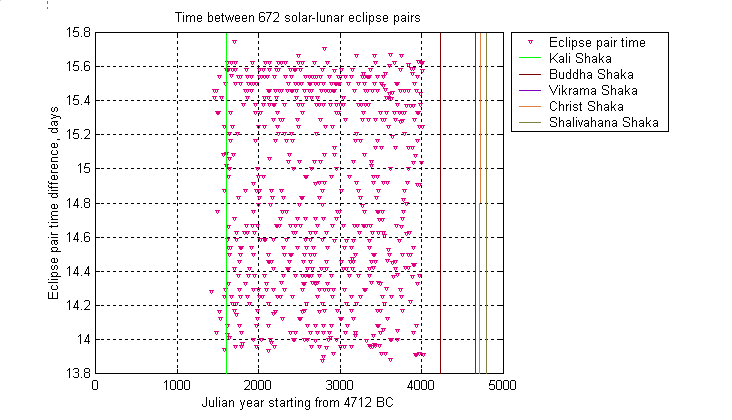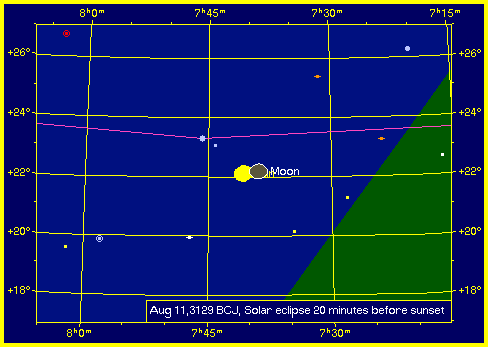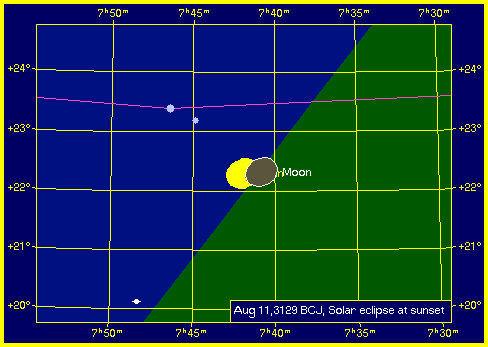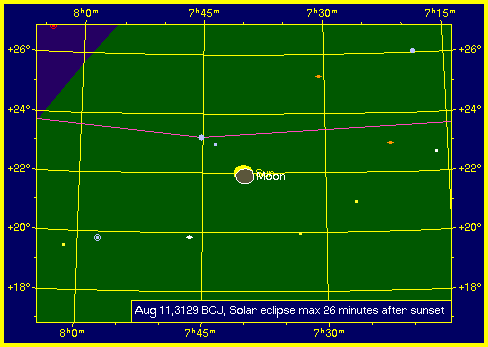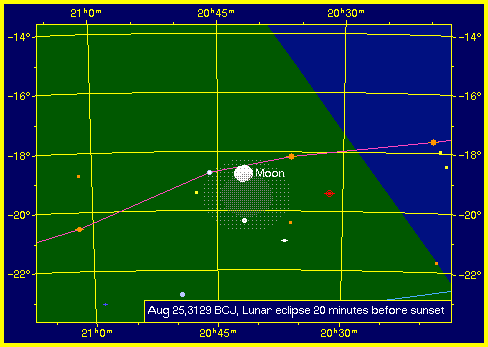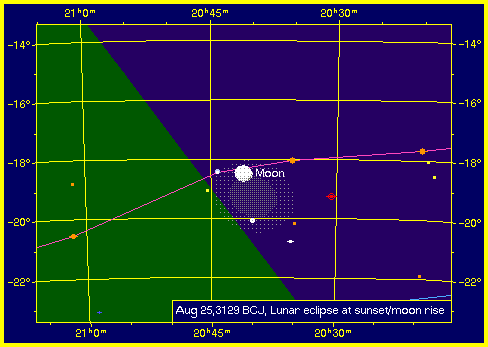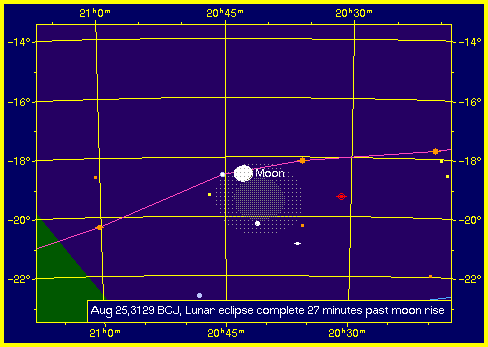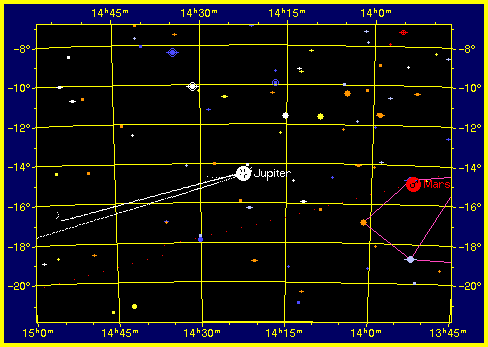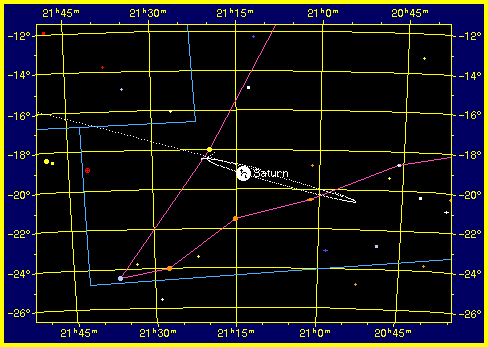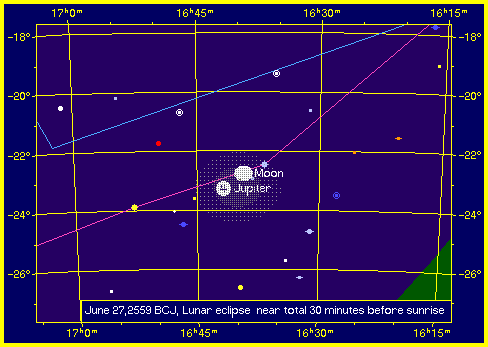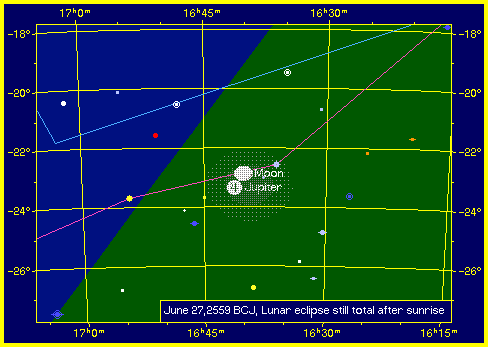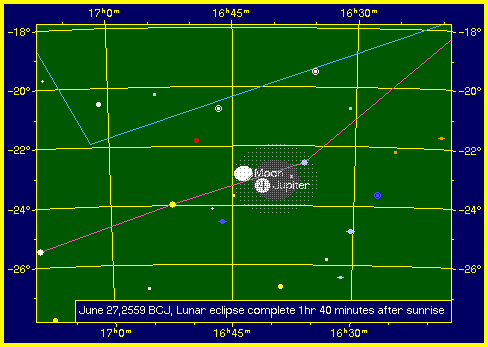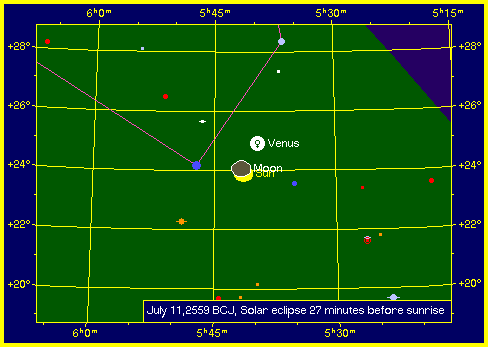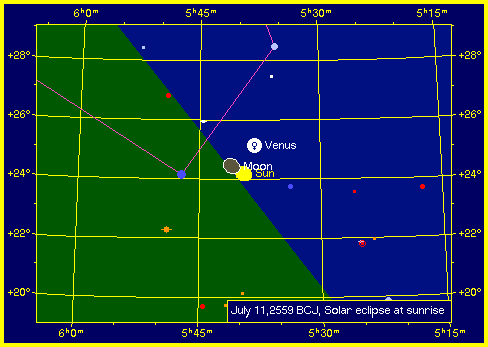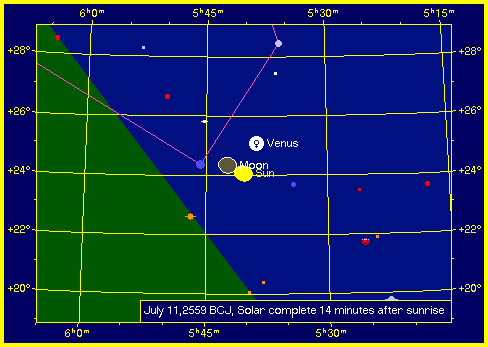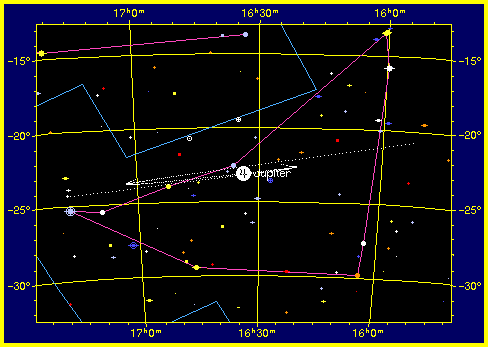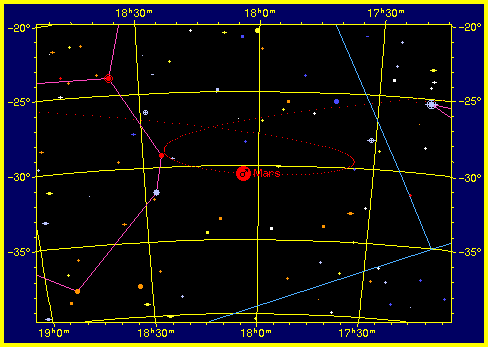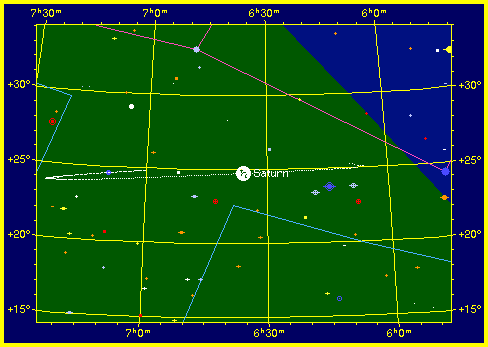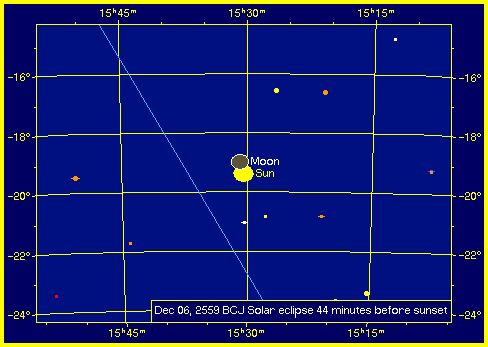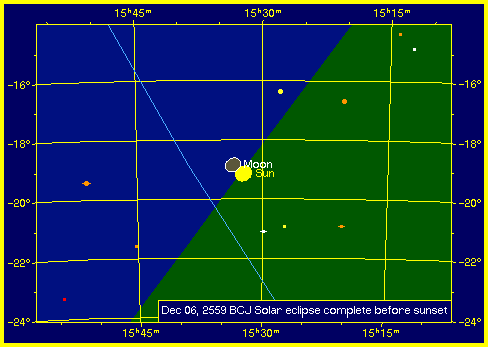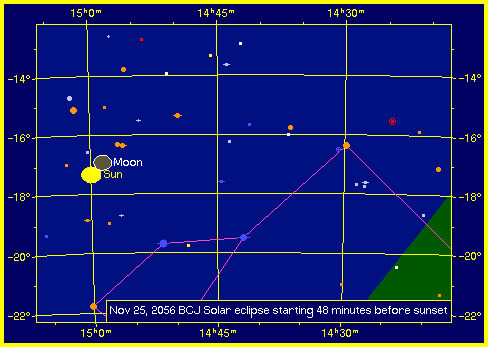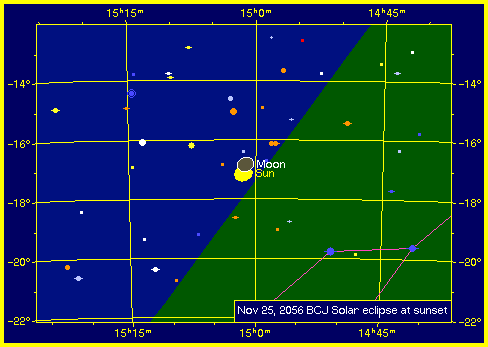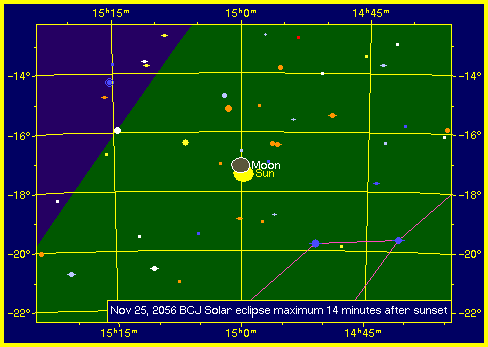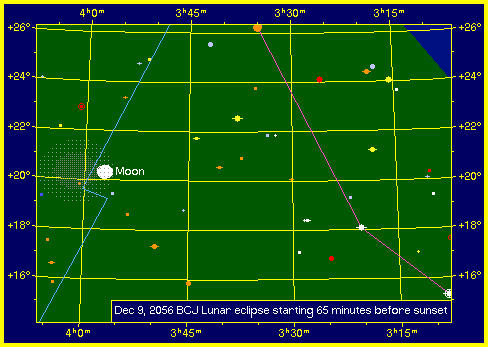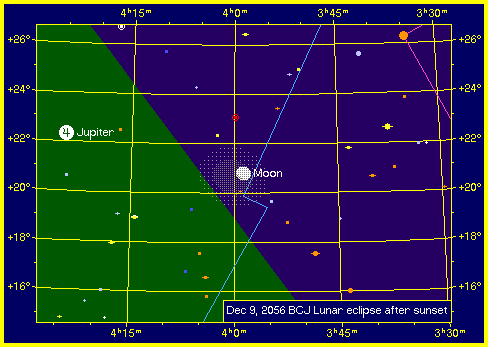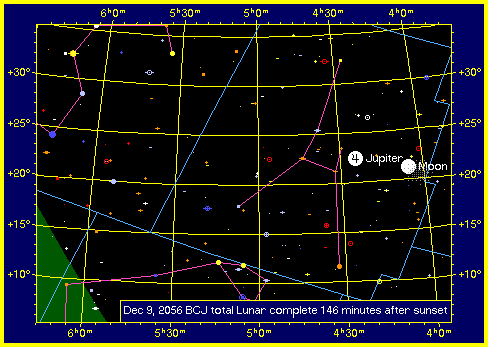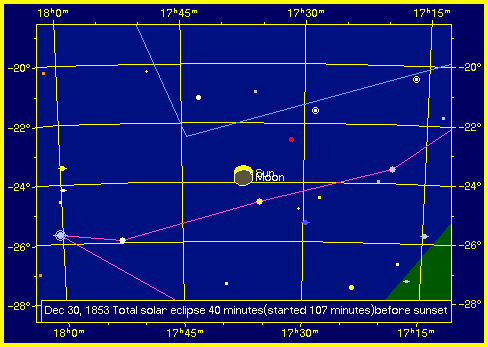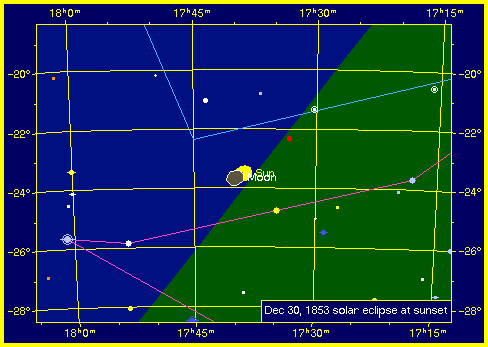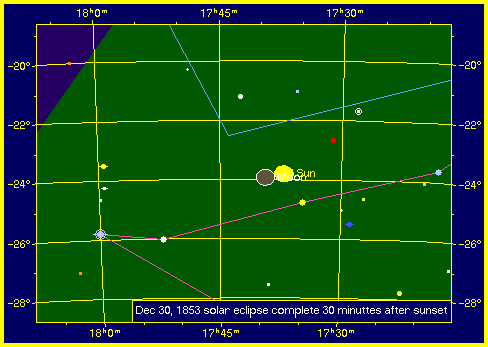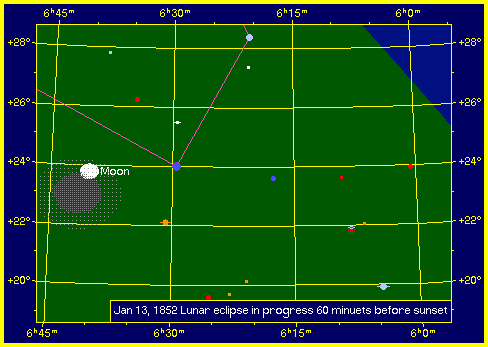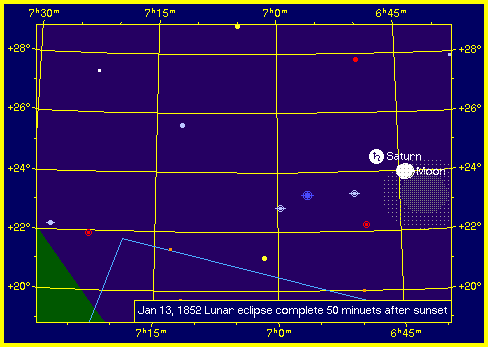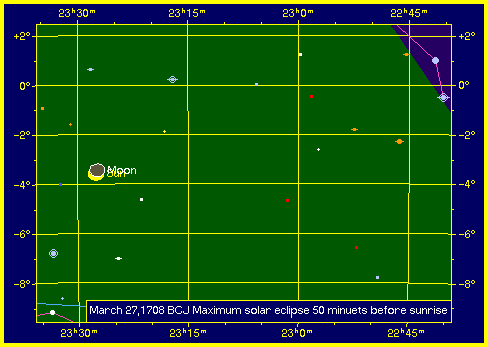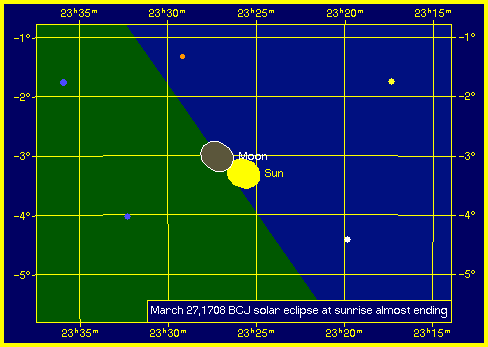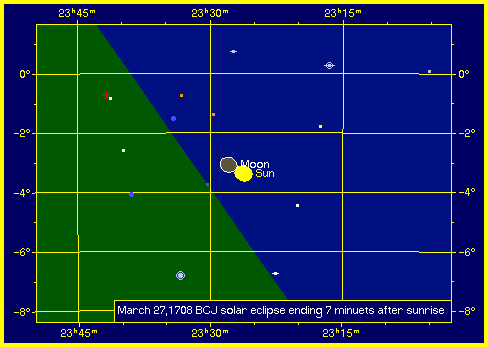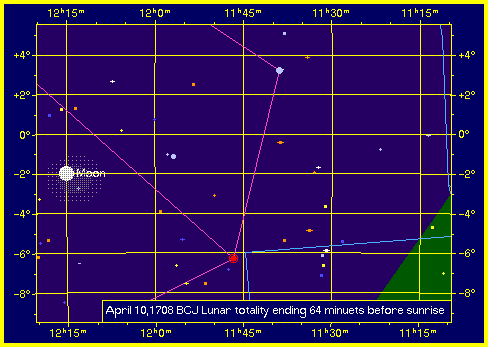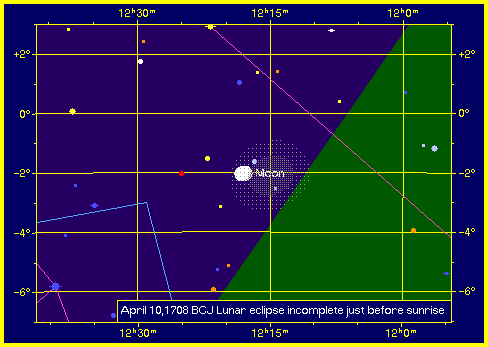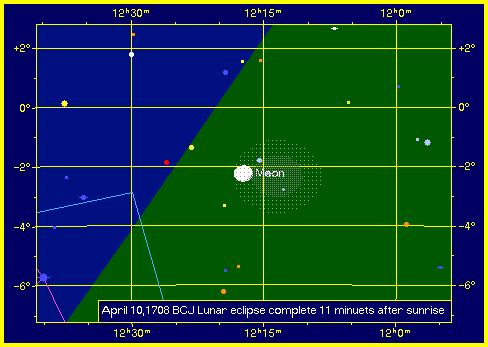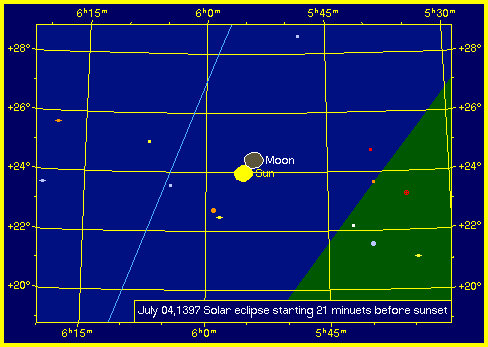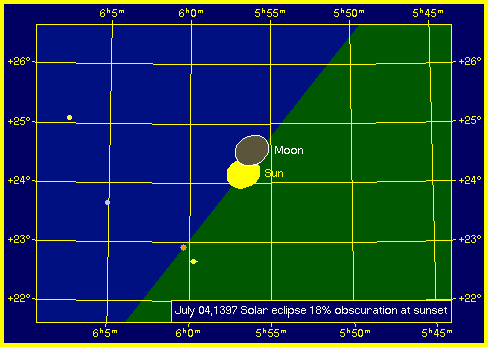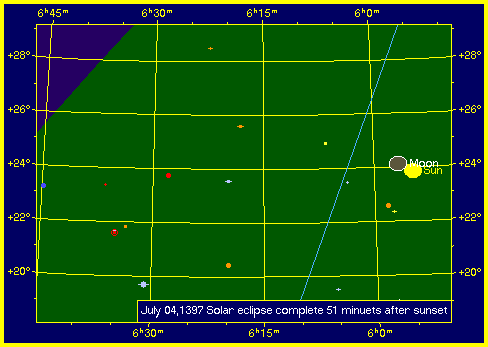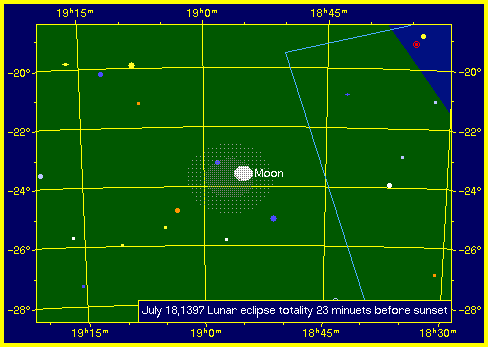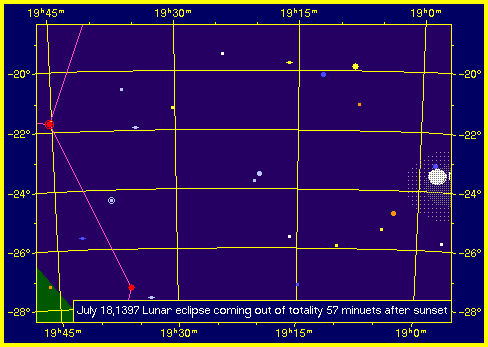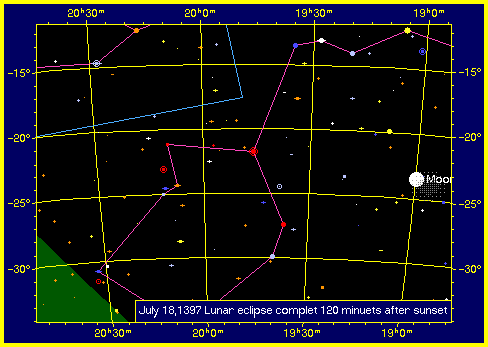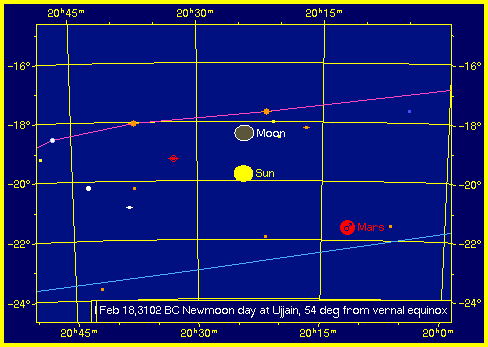 |
 |
|||||||||
|
||||||||||
During the period of our interest, 3500BC to 700 BC, nearly 4350 Lunar Eclipses and 6960 solar eclipses have occurred on earth. Of these nearly 673 solar and lunar eclipses occurred in pairs of time gap of about nominal 15 days corresponding to roughly half lunar month. We need to search amongst these 673 for an eclipse pair visible in Kuruxethra, which occurred in "thirteen" days. A very detailed scan of all the visible lunar and solar eclipses for every year from 3300BC to 700 BC was made on the Lodestar software for Kuruxethra location. These were sorted as pairs of eclipses occurring back to back in about 15 days. The aim was to identify such eclipse pairs and for each determine contact time, maximum eclipse time and release time with the relevant sunrise time or sunset time. These are tabulated. Maximum eclipse time gap (end of one eclipse and beginning of next eclipse for naked eye observers) was found to be about 379 hours while the minimum was about 332 hours. A plot of time gap between back-to-back eclipses versus eclipse pair number is shown below. (This time corresponds to maximum to maximum – not end of one to beginning of next as in the future table).
The plot shows that during the period 3300BC to 700 BC, (Julian year corresponds to zero at 4712 BC- an imaginary date- Our range corresponds to 1412 Julian year to 4012 Julian Year) nearly 672 pairs of eclipses occurred on earth, which in principle may have been visible at Kuruxethra. Amongst these nearly 32 pairs would be occurring for period less than 14 days. Some of them were found to be weak penumbral eclipses of moon. Some solar eclipses had such low obscurity as to raise the issue whether any body could see it. The plot above shows time between maximum eclipse to next maximum eclipse, which would be considered as beginnings of Shukla pratipat and Krishna pratipat or vice versa. A more detailed study of the 18 pairs (fourteen of 32 had very weak eclipses dominated by penumbral eclipse) has been made with a view to precisely determine the initial visible contact of eclipse, the maximum eclipse and the release or end time. Definition of Day and issue of timing determination It is easy for us, in present time, to precisely analyze the eclipse times based on a 24 hour per day time clock. However many thousand years ago, such a time evaluation would clearly be irrelevant. Hence the count of the day and time had to be based on clear, natural and unambiguous events such as sunset to sunset or sunrise to sun rise. Hence in all the analyses, presented below, the time of relevant sun rise or sun set is indicated such that the eclipse beginning and end can be evaluated with reference to the sun rise or sun set. In modern day definition, the period from sunrise to next sunrise is never 24 hours except on equinox day. On all other days, the time will be either less than 24 hours (when day light time is shrinking) and more than 24 hours (when day light time is increasing). For people of ancient times, sunset-to-sunset or sunrise-to-sunrise day definition would be a very logical one As will be illustrated, all the eclipses are shown to occur though sunset or sunrise, making the day count round off easy. The table below shows eighteen pairs of eclipses, which can be analyzed further to determine whether Mahabharata war and events could occur then. Eighteen eclipse pairs visible at Kuruxethra occurring in less than or near 14 days Events in red not visible due to sun rise(Lunar) or sun set(Solar)
Location of Kuruxethra 76deg49 min East, 29deg 59min North Amongst the eighteen pairs of eclipses, nine pairs have sunrise or sunset occurring in the middle, and these would form ideal candidates for consideration for Mahabharata war. The other nine sets have in them only one sunrise or sunset transition and hence are not so ideal. Only six of the pairs occur in the early morning sunrise time while the other twelve occur in the sunset time. After serious analysis of all the eclipses, six eclipse pairs from 3129 BCJ, 2599 BCJ, 2056 BCJ, 1853 BCJ, 1708 BCJ and 1397 BCJ clearly are the best candidates for Mahabharata war year from "thirteen day" eclipse pairs view point. The other twelve have low obscurity for solar eclipse, or have dominant penumbral lunar eclipse content and hence do not constitute strong candidates for the Mahabharata war In the following pages, these six eclipse pairs are illustrated using Lodestar Pro views during relevant sunset/sunrise periods. Each picture shows eclipses in various phases, the observability dependent on, in case of lunar eclipse after sunset, and in case of solar eclipse before sunset. The light/day transition is clearly shown in all the eclipse, which would form the only method of determining that the eclipses occurred in less than fourteen days, which has to be called thirteen-day eclipses. In some typical cases (not all cases), motion of Sani and Brihaspati, Shukra in retrograde are illustrated for period around the eclipse pairs. Solar-Lunar eclipse pair from Julian year 3129BC
Fourteen days later at the same time
The figures above show the pictures of night sky for a pair of Solar-Lunar eclipses, end of lunar eclipse being only 13 days and 20 hours before start of a solar eclipse. Any observer would have easily concluded that the eclipses occurred in less than 14 days because of sunset/moonrise occurring in middle of both the eclipses. On Julian August 11 afternoon, a solar eclipse begins at 6:54 before sunset and it is still on going at sunset at 7:14. Fourteen days later (On Julian August 25) in the evening at sunset a lunar eclipse is already occurring suggesting it started on the 13th day after the previous eclipse! Clearly the end of lunar and start of solar eclipses were less than 14 days or occurred in 13 days. This could be concluded without the benefit of modern clocks. The dates of this eclipse pair are Julian 3129 and Julian month of August. In ancient Bharata, since the full moon occurred on Proshtapada in Meena, the month would be considered as Bhadrapada. Normally, this is the monsoon rainy season in North India. However, there are many occasions when monsoon fails. The epic states that draught like conditions existed. Even during normal monsoon the sky is occasionally clear for the eclipses to have been witnessed. The two planets Jupiter, and Saturn are in motion (vakri) and these do occur during 3129 JBC as illustrated below. Motion of Angaraka or Mars is normal.
Items in red show retograde or Vakri motion
The location of the planets at the time of eclipse pair is shown in table above. Clearly, only Brihaspati, and Shukra are the planets at the location indicated in the Mahabharata text. Hence this date of 3129 BCJ is a serious candidate for consideration of Mahabharata war. The eclipses occur some time before the actual war, and there is a suggestion that another solar eclipse occurred in the evening during war, the Jayadhratha episode. However, no eclipse was found in December period, before the winter solstice or uttara ayana. Lunar-Solar eclipse pair from Julian year 2599 BC
June 27,2559 BCJ Start of Lunar eclipse 3:29AM Lunar eclipse total before sunrise 5:06AM
Lunar eclipse continues after sunrise ending at 6:57AM
July 9,2559 BCJ Solar eclipse max at 4:36 AM before Solar eclipse continues through Sunrise 5:12 Am Sunrise Occurs near Magha or Regulus
Solar eclipse ends at 5:24 AM, 12 minutes after sunrise The figures above show the pictures of night sky for a pair of Solar-Lunar eclipses, end of lunar eclipse being only 13 days and 20 hours before start of a solar eclipse. On Julian June 27,2559 BC morning, the lunar eclipse, which started at night, is not complete. Fourteen days later (On Julian July 11,2559) in the morning at sunrise the solar eclipse is already occurring and is almost over suggesting it started on the 13th day after the previous lunar eclipse. Clearly, even to the observers then, the end of lunar and start of solar eclipses were less than 14 days or occurred in 13 days. The figures show that during lunar eclipse, occultation with Jupiter was also going on, a very rare event. Whether this has been noted somewhere in the Mahabharata text, is to be explored. Also, there is a near Venus occultation during solar eclipse. The near Venus occultation occurring is to be looked for in Mahabharata text.The dates of this eclipse pair are Julian 2559 and Julian months of June and July. In ancient Bharata, since the full moon occurred on Shravana nakshathra in Makara, the month would be considered as Shravana. Normally, this is the monsoon rainy season in North India. Mahabharata text does refer to draught like situation in the text. The three planets Jupiter, Saturn & mars are said to be in retrograde motion (vakri) and these do occur during 2559 JBC as illustrated below.
Jupiter (Brihaspati) in retrograde motion (vakri) Mars(angaraka) in retrograde motion(vakri) May to September 2559 May to September 2559
Saturn(Shani)in retrograde motion in December 2559 Items in red show retograde or Vakri motion
Clearly, the Planet positions from Mahabharata text do not totally match the planet positions at the time of eclipse pair. But Brihaspati is near the indicated location as per Mahabharata text The ominous 13-day eclipse occurs in month Shravana. Some months later, during the war, which occurred before the winter solstice, it is said that Jayadhratha was killed when Sri Krishna covered the sun for a short time just before the sunset. This could be looked upon as a solar eclipse. A study of year 2559 shows that another solar eclipse did occur in Pushya lunar month nearly six months after the short eclipse pair. It occurred shortly before sunset as illustrated below.
Clearly this episode can provide an explanation for events prior to Jayadhratha’s death. The Lunar month then was Pushya and sun is still at 19.5 degrees south in Dakshina Ayana. He still has to move to 23.5 degrees (thirty six days away) to reach Uttara Ayana (which occurs on Jan 10, 2558 BCJ) at which time war was over and Bhishma passed away. Hence 2559 eclipse pair can be considered to be fairly serious candidate for Mahabharata war year. Solar-Lunar eclipse pair from Julian year 2056 BCJ
This pair of eclipses also is a viable pair for Mahabharata date. The eclipse pairs occur in Margashira/pushya lunar months as is evident from above picture. As before, naked eye observers can make out the fact that end of solar eclipse and beginning of lunar eclipse are less than 14 days apart. The table below provides the trajectories of five naked eye planets. The motions of Brihaspati and Sani are retrograde as suggested by Mahabharata text, but the locations are not at the proper nakshathras. Items in red show retograde or Vakri motion
Hence this pair of "thirteen day " eclipses does meet the Mahabharata period requirements. Solar-Lunar eclipse pair from Julian year 1853 BCJ
This eclipse pair occurs in month of Magha as the full moon is near Magha nakshathra. This is a bit too late for Mahabharata war as the sun is very near winter solstice already at 24 degrees) or uttara ayana. Items in red show retograde or Vakri motion
Two planets Sani and Brihaspati are in retrograde motion, but all planets are at positions, which do not agree with Mahabharata text. Thus this pair of eclipses though meeting the "Thirteen day" requirement, occurs very near the solstice to be serious candidate for Mahabharata. Lunar-Solar eclipse pair from Julian year 1708 BCJ
Items in red show retograde or Vakri motion
The locations of the planets during the eclipse pair are totally different from the Mahabharata text. However, the planets Brihaspati and Sani are in retrograde motion. The eclipse pair occurs just after the beginning of Uttara Ayana in winter, and the fact that there was a draught cannot be seriously considered. Hence this date is rather a weak candidate for the Mahabharata eclipse pair. Lunar-Solar eclipse pair from Julian year 1397 BCJ
Items in red show retograde or Vakri motion
This is the last eclipse pair that meets the "thirteen day" period requirement in our search.The season is right. The two retrograde planets Brihaspati and Sani are very near declared positions. There is no solar eclipse in the period prior to Uttara Ayana. This eclipse pair is a good candidate for Mahabharata war. This new date is very different and more recent than the traditional dates by Aryabhata, Surya Siddhanta, Varaha Mihira Beginning of Kaliyuga The SuryaSiddhanta based data declare that the Kaliyuga started on the new moon day (Amavasya/Pratipat) when sun was 5 degrees away from vernal equinox (Ref 2). This date has been estimated as February 18, 3102 BCJ. There is also a suggestion that there was a solar eclipse at Ujjain. The picture below shows the view and sun and moon at that time.
The Lodestar pro view of sky on that day shows that there was no eclipse at Ujjain (75 deg 47 min E and 25 deg 15 min N) at Amavasya, but sun was 54 degrees away from vernal equinox. (3 hours 36 minutes from equinox- @15 deg/hour this works out to exactly 54 degrees).
|
|||||||||||||||||||||||||||||||||||||||||||||||||||||||||||||||||||||||||||||||||||||||||||||||||||||||||||||||||||||||||||||||||||||||||||||||||||||||||||||||||||||||||||||||||||||||||||||||||||||||||||||||||||||||||||||||||||||||||||||||||||||||||||||||||||||||||||||||||||||||||||||||||||||||||||||||||||||||||||||||||||||||||||||||||||||||||||||||||||||||||||||||||||||||||||||||||||||||||||||||||||||||||||||||||||||||||||||||||||||||||||||||||||||
